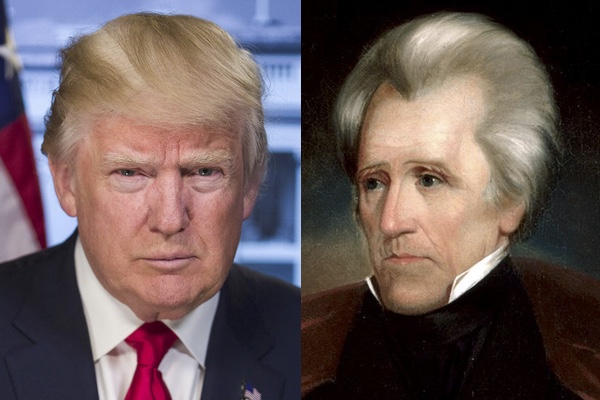Donald Trump Is Really Like Andrew Jackson in this One Way

Donald Trump ran on a campaign to “Make America Great Again,” and in that vein during a recent visit to the Hermitage, Andrew Jackson’s home, Mr. Trump said he sees Jackson as a reflection of himself. The latter point is not surprising since the current President had previously hung a portrait of Old Hickory in the Oval office. There have been several apt comparisons of the two men, but most have missed an important point.
Both men won the presidency in part through racist rhetoric and actions, the most egregious of which were directed toward Indigenous Americans and African Americans. Daniel Walker Howe’s Pulitzer Prize winning What Hath God Wrought demonstrated that Jackson won election because of votes in the South and the West where his support for slavery attracted Southern planters and his advocacy of Indian removal appealed to western farmers. Similarly, Mr. Trump’s call for a wall on the Mexican border and his acceptance of endorsements from racists like David Duke played to the prejudices and interests of certain circles in white America. The similarities between Jackson’s Indian Removal, and Trump’s proposed wall and ill-defined deportation plans are particularly noteworthy and beg some comparisons.
One might challenge the existence of parallels here by asserting that Mexicans are Latinos, not Native Americans. But the vast majority of Mexicans have Indigenous American ancestors. According to the CIA World Factbook, 90% of Mexico’s population has Native American blood: 62% are Mestizo, having an indeterminate amount of Native blood; 21% are predominantly “Amerindian”; 7% are entirely Native American; and 10% are classified as other, most of whom are of European ancestry. While the United States Bureau of Indian affairs leaves the issuance of Indian Cards to the tribes, 90% of Mexicans would probably qualify here based on their bloodlines.
The background of Mexico’s population is often lost to United States citizens because the term Latino is generally used to describe that population and because, at the time Europeans arrived in America, Mexico’s indigenous people had developed beyond the hunting and gathering traditions of many Natives to the north and were advanced agriculturalists and builders. In fact, the nutritional yield per acre of Mesoamerica and parts of South America exceeded Europe in 1492 as a result of the development of crops like corn and potatoes and sophisticated methods of fertilization. Moreover, the building skills of these Natives astonished conquistadors like Bernal Diaz del Castillo, who accompanied Cortez to Mexico. Historians and archaeologists also have noted that writing, the use of zero and higher math each developed in four places on the planet, the city states of Mesoamerica being one point of origin for each of these advancements.
Following the Spanish conquest, Native manuscripts were systematically destroyed and the Spanish language was imposed on the region. The Spanish exploited Native agricultural knowledge and building skills on large haciendas where Natives were often caught up in a system of peonage through a combination of debt and force. A Spanish caste system in Mexico rendered an environment where those with the highest percentage of Native blood were most likely to be at the bottom of the economic pyramid and thus most likely to flee for freedom or to be forced to migrate in search of sustenance.
To fully appreciate the similarities between Trump’s wall and deportation plan, and Jackson’s, Indian removal, it is necessary to recall that Native peoples had migrated up and down the western coast of North America in search of subsistence and security for tens of thousands of years before the arrival of Europeans. For example, historians generally believe that the Mexica or Aztecs migrated south from what is now Texas. Such migrations did not stop with the arrival of the Spanish and the English, nor with the independence of the United States and Mexico. The movement of Native people was restricted, however, when European-Americans pushed west and especially after 1848 when the United States annexed the northern half of Mexico following the Mexican War. Trump’s call for a wall and mass deportations, like Jackson’s demand for Indian removal, played the race card and won votes by ostensibly expanding opportunities for white Americans while limiting those of the descendants of North America’s original inhabitants.
Many have pointed to similarities between Presidents Trump and Jackson; however, contrary to Mr. Trump’s campaign slogan, the similarities in their elections and many of their actions are diametrically opposed to the qualities most associate with America’s greatness.